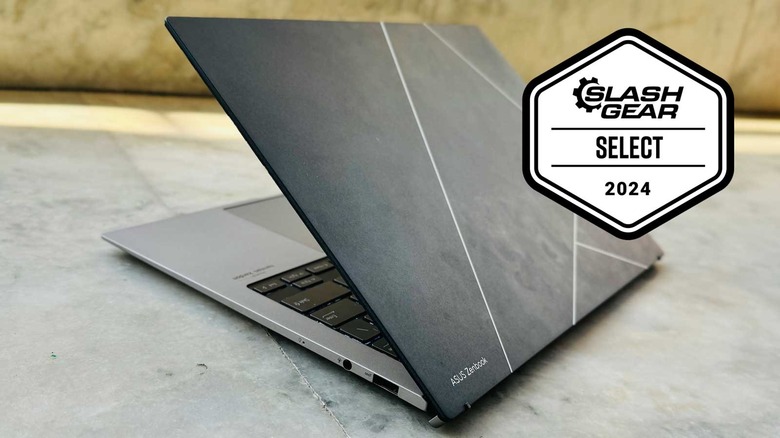
Nadeem Sarwar/SlashGear
EDITORS’ RATING : 8 / 10
- Amazingly thin and light with great build quality
- Gorgeous OLED display
- Versatile I/O port situation
- Plenty of firepower
- Great keyboard for such a sleek profile
- Runs hot under load
- Needs more resource and battery optimization
- Dolby Atmos is a wasted trick for the speakers
- A microSD or SD card reader would’ve been nice
- Windows and Intel x86 need more camaraderie
It’s not an everyday occurrence that you find yourself using a laptop that is thinner than your phone. Not only is the Zenbook S13 OLED skinnier than the MacBook Air, but also the OnePlus Open, which itself is one of the slimmest foldable phones out there. A healthy dose of skepticism is warranted when a brand makes tall claims about going thinner and lighter than the competition and eventually delivers a whole bunch of compromises with all the braggadocio.
That doesn’t seem to be the case here. Asus has armed this thin and light machine with up to an Intel Core Ultra 7 processor, up to 32GB of RAM, and 1TB of fast SSD. Another key selling point of this machine is the OLED screen, which is arguably one of the nicest elements of this device. Moreover, this is an Intel EVO machine, which means you can expect niceties like instant wake-up, fast charging support, Thunderbolt 4 ports, and more.
In fact, Asus has managed to cram more ports — and of varied kinds, mind you — on the Zenbook S13 OLED than an ultrabook deserves. Overall, this one seems like a solid option for anyone averse to the ubiquitously stingy MacBook dilemma, but still on the hunt for something portable as well as plenty powerful. We pushed the Zenbook S13 OLED in a bunch of challenging scenarios, and what follows is a detailed look at its strengths and weaknesses.
Design and build
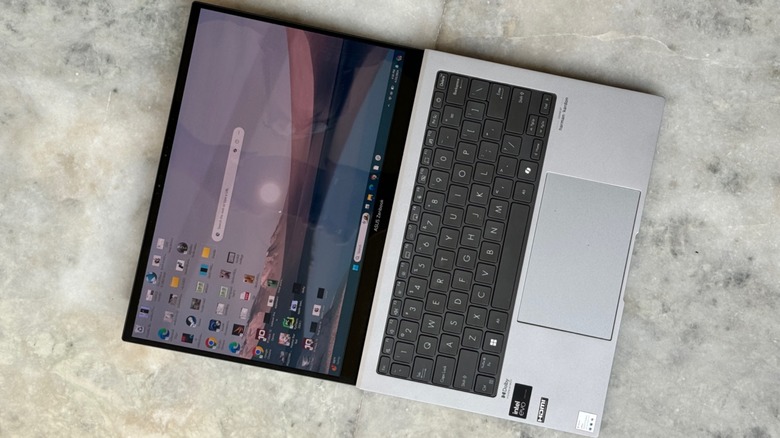
Nadeem Sarwar/SlashGear
Asus’ latest ultraportable is, by a healthy margin, one of the nicest laptops to carry around. It’s pleasantly thin, light, and built assuringly well. It follows a wedge-shaped design that has been a mainstay on Zenbooks for a while now. But this time, Asus is going for a dual-tone approach, both inside and out. The black keyboard deck serves the same kind of contrasting look with the silvery metal deck as the recent crop of MacBook Pro machines.
Another shift is the size of the trackpad, which is wider, surprisingly spacious, and profoundly smooth for a laptop as small as the Zenbook S13 OLED. There is no flex to be seen on the keyboard, and neither is there any floppy movement for lid movement. It’s also quite surprising that the 2024 version comes with two fans fitted in that sleek chassis.
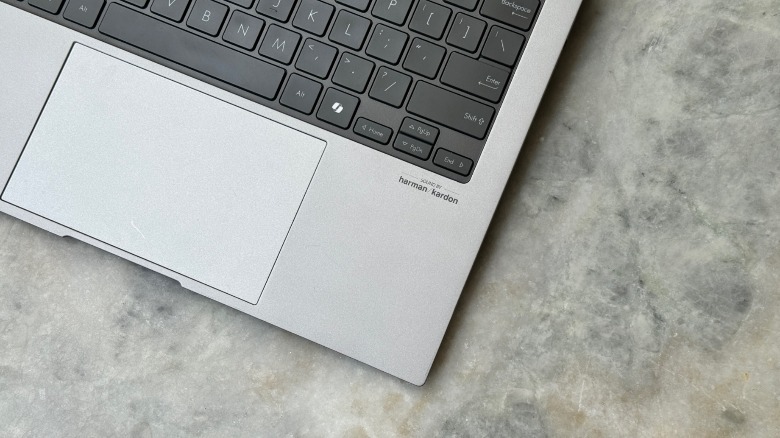
The shell is made out of recyclable metal in an environment-friendly manner. Notably, Asus says the S13 OLED is the most eco-friendly Zenbook ever made, employing elements like post-industrial recycled (PIR) magnesium-aluminum alloy, ocean-bound plastic, and post-consumer-recycled (PCR) plastics. Asus calls it plasma ceramic aluminum, but for a buyer, it’s simply a job well done. It has a beautiful satin-like texture that feels great to touch, but unlike the MacBook Air, doesn’t leave nasty smudge marks.
Moreover, it is a military-grade MIL-STD-810H-certified build that is at play here, so you can sleep easy knowing this machine can brush off a few accidental bumps. This is the kind of machine you want to carry around like a notebook. It’s not quite the 12-inch MacBook, but if that machine were to reincarnate as a Windows laptop, the Zenbook S13 OLED would be it.
I/O situation
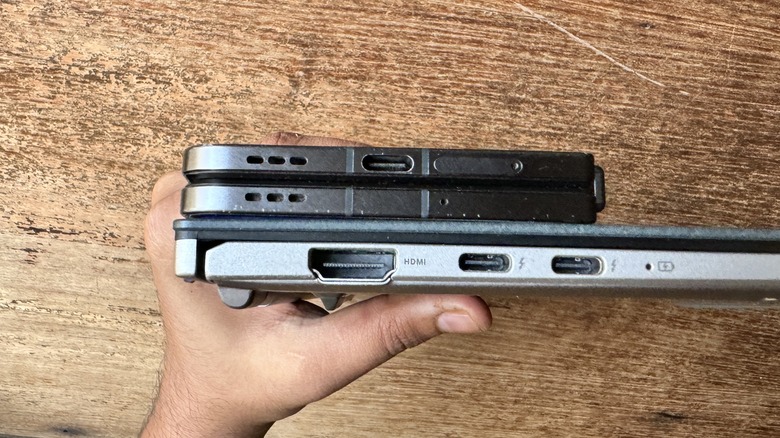
Nadeem Sarwar/SlashGear
More than sleek looks and a beautiful two-tone eco-friendly build, there’s also a functionally rewarding side to the ZenBook S13 OLED that is hard to find on slim and airy machines like this. Where the MacBook Air plays notoriously stingy with the port selection, you get a healthy few on the Asus offering. Asus’ engineers really went out of their way to use every single millimeter of depth afforded on the slim sides and carve the space for ports.
The manner in which the headphone jack, USB-A, and HDMI port have been accommodated should put every other brand to shame, especially Apple. On the left are a pair of USB Type-C Thunderbolt 4 ports and a full-sized HDMI 2.1 port. On the right edge is a USB Type-A (v3.2 Gen 2) and an audio combo jack. It may not sound like much at first, but not having to carry a hub or USB converter for something as basic as connecting a mouse is something you really appreciate after living with a laptop devoid of ports.
The Zenbook S13 OLED is a masterclass in functional design in a few other ways. The ErgoLift hinge, which lifts the keyboard base at an angle, elevates the whole deck and offers a more comfortable typing experience than machines like the MacBook Air on which it lies flat. It’s the little ergonomic genius here that really helps the typing convenience. The space underneath also allows for better airflow to keep the laptop running cool.
Display and sound
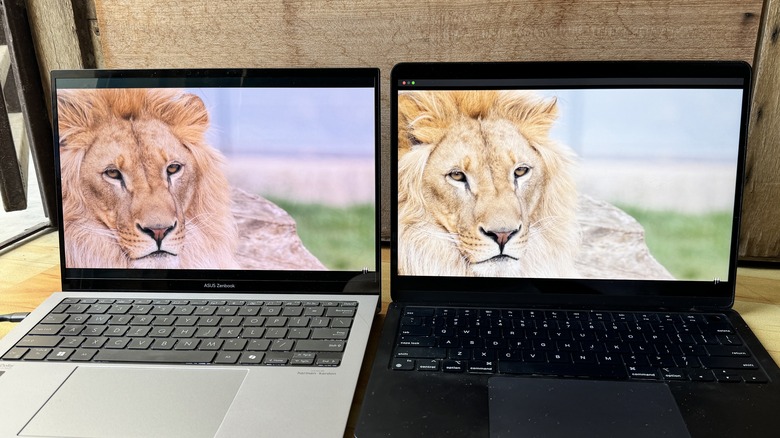
Nadeem Sarwar /SlashGear
One of the biggest perks of Asus’ slim laptop is the screen, which is a 13.3-inch OLED HDR panel with impressively thin bezels and a 16: 10 aspect ratio. Asus is touting perks like a 1,000,000:1 contrast ratio and 600 nits of peak brightness, a 70% reduction in blue light emission, and a handful of «OLED care» features that keep issues like pixel burn-in at bay. I ran the EIZO display quality test on this machine and the panel passed the uniformity, gradient, viewing angle, and pattern assessments with flying colors.
Talking about colors, it is one of the nicest screens I’ve ever seen on a laptop. It is delightfully bright under natural light, produces punchy colors, serves great contrast, and there is little to complain about color shift either. I have held Apple’s Retina panels in high regard for a while now, but when you put the Zenbook S13 OLED side by side, you can clearly see the upper edge on the Asus machine in terms of color saturation. Depending on your visual preference, you can switch color presets and pick between DCI-P3 and sRGB coverage for creative tasks.
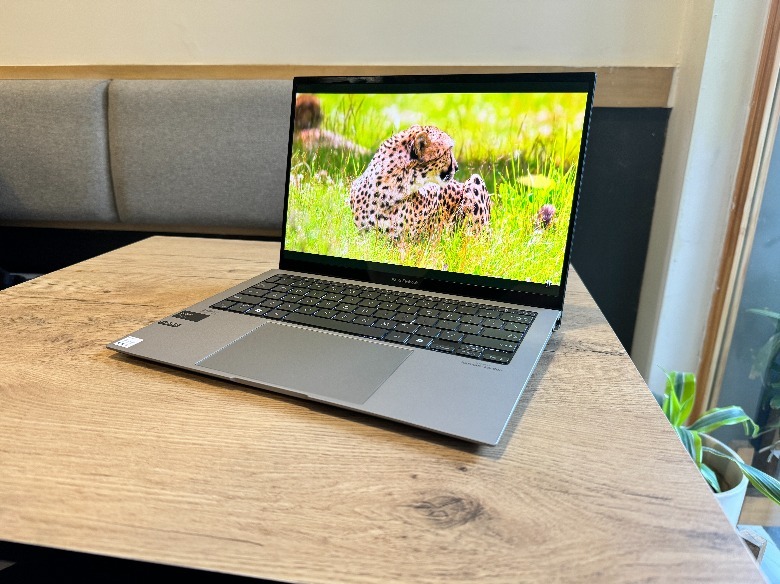
Another good part here is that the backlight is even and there is no edge bleeding to be seen here. I wish this was a 360-degree convertible so that it could double as a content streaming slate. However, there is no touch-screen support here, and the hinge only allows movement freedom up to 180 degrees. It’s not a bad deal by any stretch of the imagination, but this beautiful display deserves to be pushed to its visual limits.
Some hits and misses
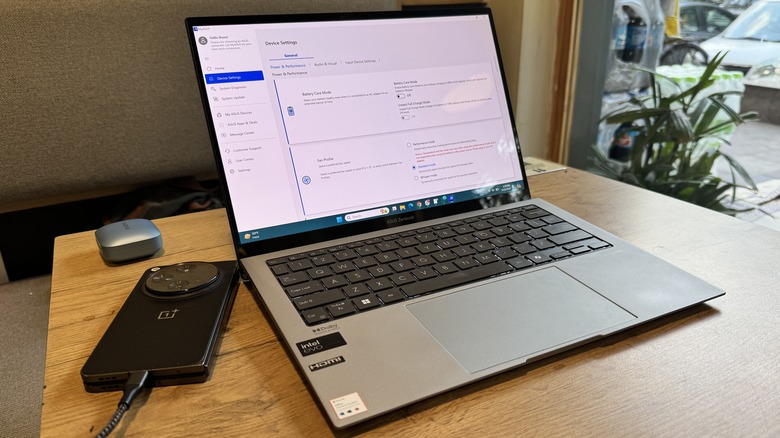
Nadeem Sarwar/SlashGear
There are a couple of Harman Kardon-tuned speakers on the Zenbook S13 OLED that also support Dolby Atmos output. They are sufficiently loud, and the best part is that even at high volume levels, there is little vocal distortion to be noticed. But something interesting is happening here. First, the sound signature is vastly different compared to the MacBook Air. Apple’s laptop offers a wider sound stage with a more surround sound feel, whereas the Asus device tries to capture the feeling of those audiophile-type headphones blasting tunes straight into the ear canal.
But the in-built Dolby Atmos trick seems to be doing something weird. When enabled, it noticeably suppresses the vocal clarity and the instrumental notes start sounding lifeless. Disabling it offers a far better listening experience. When pitted against the MacBook Air, the Asus laptop’s speakers seem to deliver a more thumping audio experience with an extra focus on treble, while Apple seems to favor a flatter, but more balanced sound profile. The Zenbook S13 OLED may not ace its Apple rival at Heilung’s «In Majdan,» but when it comes to peppy club tracks like GIMS’ «Mi Gna,» the Asus laptop sounds more pleasing.
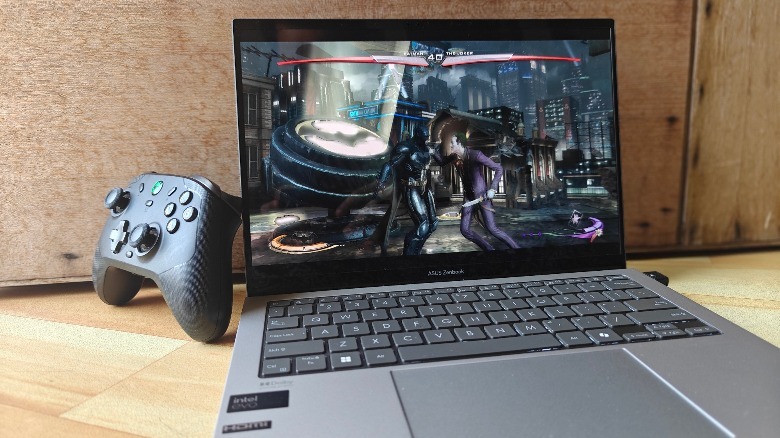
Asus says the FHD webcam comes with a suite of features like lighting correction and eye tracking in the MyAsus app, but the app’s latest version doesn’t seem to offer the «webcam effect» in its latest build. However, the motion tracking feature that keeps the subject at the center works flawlessly and the portrait blurring also does an acceptable job at subject separation even under challenging light. I also love the IR face authentication system on the Zenbook S13 OLED. Even in a totally dark room, it was quick and never failed me.
Hot, literally and figuratively
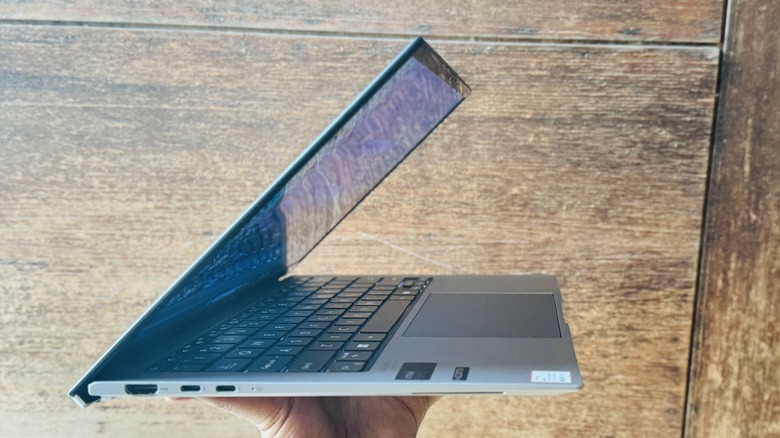
Nadeem Sarwar/SlashGear
Without a doubt, the Asus Zenbook S13 OLED is one of the hottest laptops out there. It just might win the undesirable title of running the hottest, as well. Asus’ engineers seem to have run into the limits of thermal physics in their quest to make an outrageously slim laptop, going to an extent where they seem to have decided that they’d keep the laptop running smoothly instead of performance throttling to keep it cool.
For example, with CPU load at just about 35% (with Chrome, Slack, Microsoft Teams, and WhatsApp), the temperature was 158 degrees Fahrenheit (70 degrees Celcius). And that is when the fan profile was set to Performance mode. Under the same kind of load with the fan profile set to silent mode, the heating woes get worse. That’s when even the multi-tasker starts acting up, as seen in the image below:
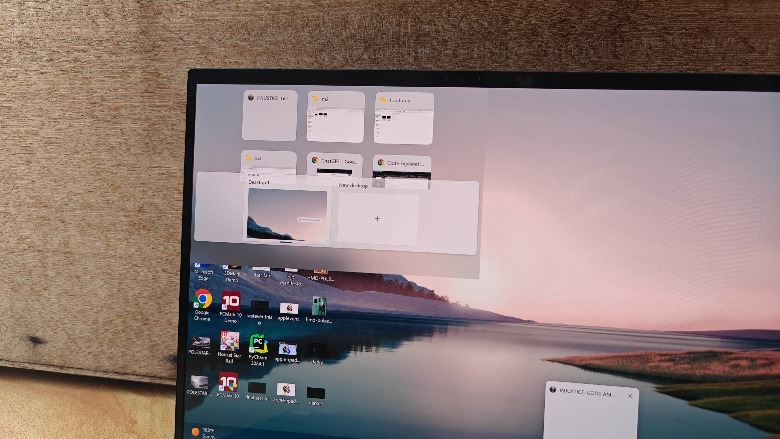
On a couple of occasions, after the upper region of the keyboard deck and the base got quite toasty, the system simply shut down following a blue screen error. Interestingly, running a diagnostic test didn’t reveal any issues with system assets or third-party software. Now, I would blame the thermal issues on the ambient temperature, as well. Sitting in a chill coffee shop kept things relatively cool and smooth.
But in open areas with the ambient temperature always above the 86 degrees Fahrenheit (30 degrees Celcius) mark, the heating issues were quite apparent. The metallic chassis certainly doesn’t lend a helping hand here, irrespective of fan speed tuning. The performance takes a hit under thermal stress, but the fans make a visible change as one shifts from quiet to performance mode. Apple has done a better job even with a fanless kit underneath the MacBook Air’s metallic chassis.
Performance
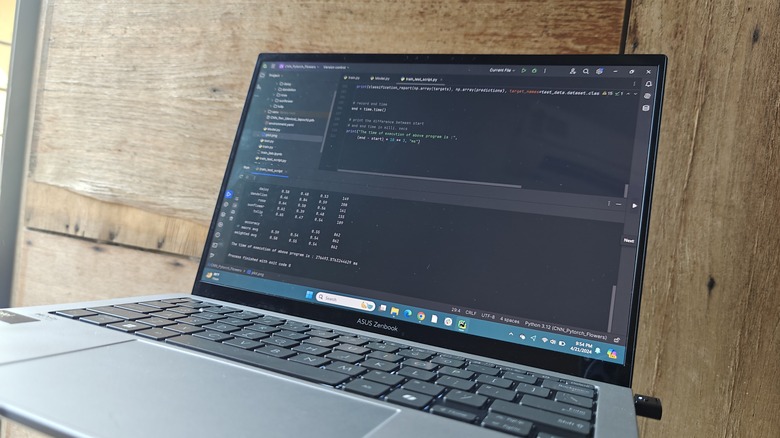
Nadeem Sarwar/SlashGear
Asus has armed the Zenbook S13 Ultra with an Intel Core Ultra 7 processor packing a total of 12 cores (2 performance + 8 efficiency + 2 low-power efficiency) that can surprisingly reach a peak output of 4.8GHz. The GPU is an integrated quad-core unit with ray-tracing support. The silicon here is a mean performer, but once again, a mixed bag of surprises and a few underwhelming moments. But here’s the most crucial question – why do you need a super sleek laptop when the same kind of cash can get you a far more powerful gaming laptop?
The answer lies in the form factor, and the utility, of course. If your daily work pipeline doesn’t involve demanding media edits and AI workflows where a GPU can make a world of difference, the Zenbook S13 OLED will blaze through whatever you throw at it. And with ease. That distinction is important because the Core Ultra 7 here is the 155U SKU, which has fewer performance cores, integrated graphics, and much lower power draw compared to the 155H SKU that ships with Arc graphics.
The true hurdle in the machine’s path is the cramped thermals, Windows’ inherent pitfalls, and resource allocation on the Intel processor. Ideally, the hardware at hand should not be a bottleneck, but slowdowns come in weird ways, especially when the system is running low on juice. Now, this is not a machine tailored for gaming, but doesn’t fail to surprise. Honkai: Star Rail was simply a terrible experience, right from the start with massive stutters on the load screen. Interestingly, I loaded Injustice: Gods Among Us (Unlimited Edition) via Steam and at HD+ resolution with texture and shadow quality at maximum range, the experience was buttery smooth.
Mettle against the Mac
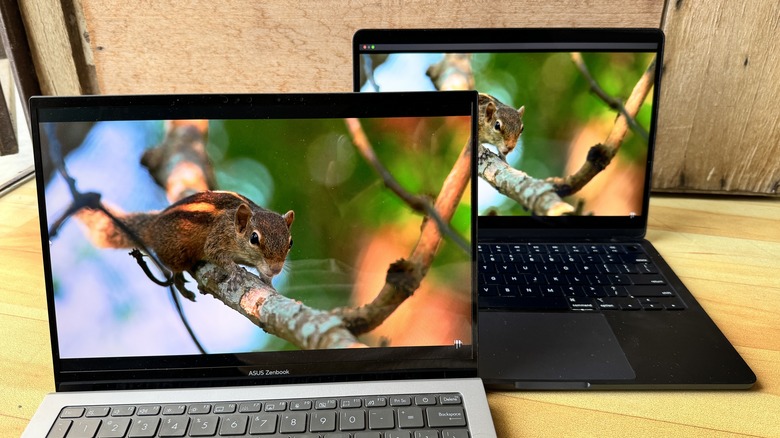
Nadeem Sarwar/SlashGear
The Intel Core Ultra 7 processor is plenty fast, but at CPU-intensive tasks, it falls behind the Apple M3 at both single and multi-core tasks by nearly 30% each. The Intel silicon falls closer to the M2 at CPU benchmark figures. But benchmarks aren’t always real indicators of a machine’s mettle, so I turned my attention to a few CPU-driven practical AI workflows. I ran a Python script pipeline for training and evaluating a convolutional neural network (CNN) to classify images of flowers.
The task requires neural network building, data handling, visualization, and evaluation, while the process entails loading images and applying transformations like resizing and converting them to tensors. At this task, the Zenbook OLED S13 OLED finished the execution in 276 seconds, roughly 42% faster than the M3. This was quite an interesting lead, as the M3 comes with an upgraded AI accelerator but was significantly slower than the Intel Core Ultra 7.
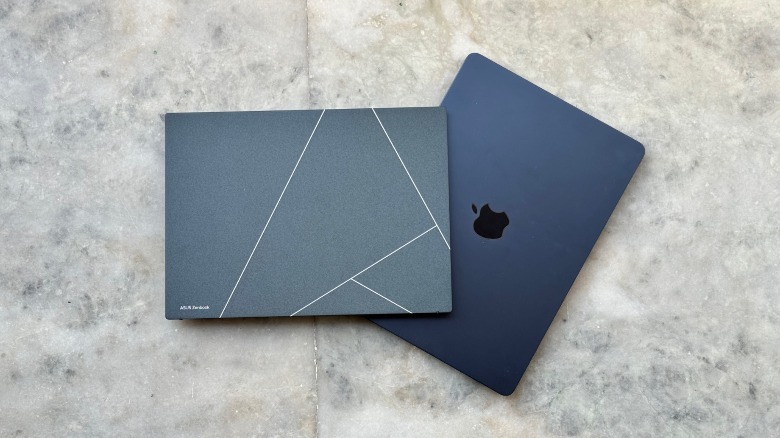
Next, I ran a Python script that uses a Machine Learning technique called multi-layer Perceptron (MLP) regression for predicting wine quality after training on a dataset. The Zenbook S13 OLED’s execution time was 10 seconds, which was 51% faster than the M2 but 41% slower than the M2. Finally, I moved away from ML-based workflow and tried an unsupervised learning task that performs image segmentation using the K-means clustering algorithm to segment an input image into multiple clusters based on pixel colors.
The Asus machine’s execution time was 17 seconds, barely 1.1% behind the M2 and 22% slower compared to the M3 inside the 2024 MacBook Air. In a nutshell, for cloud-based AI tasks, the Zenbook S13 OLED will work just fine and won’t leave you yearning for a MacBook Air.
Battery Life Testing

Nadeem Sarwar/SlashGear
The Zenbook S13 OLED is an Intel Evo-certified machine that comes equipped with a 63-watt-hour battery claimed to last 14 hours. With a workflow fitting for an ultrabook, I averaged around 10 hours on a single charge with the brightness always above the 70% mark. Indoors, when running the machine at the lowest fan profile and brightness levels close to the midway mark, I reached close to 11.5 hours on a single charge. That’s not bad for a machine this size, and especially one that serves an OLED display. But it’s not quite there yet when the MacBook Air comes into the picture.
But under load, the battery drain is comparatively quicker, and the same is the situation if the fans are whirring in performance mode. In the opposite situation, you’re staring at a performance compromise. For example, as soon as the PC shifts to power-saver mode, the throttling is a little too aggressive. But the tale is familiar across a majority of slim Windows machines, even Microsoft’s Surface slates. The Macs, especially those with the Apple M-series silicon, typically don’t serve that kind of battery-linked bother.
But it’s worth noting here that Apple has end-to-end control on Mac development. On the Zenbook S13 OLED, Asus can only do so much optimization with an OS and silicon provided by two different companies. However, Asus has done a better job compared to Acer’s Swift and Dell’s XPS Plus at battery endurance, which is a solid competitive edge. I dearly hope this machine gets the Arm treatment with one of Qualcomm’s upcoming Snapdragon X processors to really shine.
Verdict
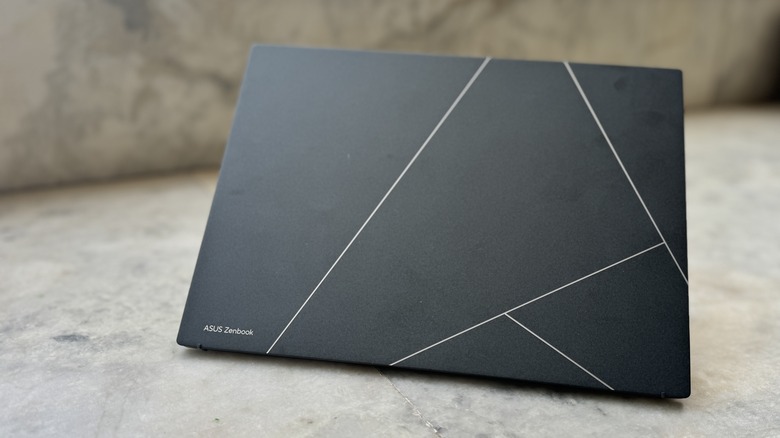
Nadeem Sarwar / SlashGear
With the Zenbook S13 OLED, Asus is offering an ultrabook that is also functionally rewarding. The build quality is top-notch, the keyboard is amazing, and there is a welcome diversity of I/O ports. It also serves a beautiful OLED screen that is married to perks like 65W fast charging, both of which put the latest MacBook Air to shame. But this machine is not all about slim looks and barely-there heft.
The Intel Core Ultra 7 processor holds its own against Apple’s venerable M-series processors even at AI workflows. If you are in the market shopping for a slim and light machine, the performance of this Asus laptop won’t leave you wanting for more. But there are a few pitfalls to keep in mind, all of which are unfortunately inevitable for Windows-based ultrabooks.
When pushed, this sleek laptop runs hot and throttling becomes evident if you’re trying to be frugal on the battery. But having tested a healthy bunch of laptops in this segment, I feel the Zenbook S13 OLED (2024) hit the limits of PC engineering finesse. Windows continues with its OS hiccups and Intel still has a long way to go before its x86 silicon can match the resource optimization chops of Apple’s Arm-based silicon.
For now, the Zenbook S13 OLED comes closest to the summit where the Macbook Air is hailed as the default choice and even beats it at a few crucial aspects. At $1,399 for sale directly from ASUS, it’s not exactly cheap, but when you factor in the generous RAM and storage situation, it actually emerges as a better value for your money.